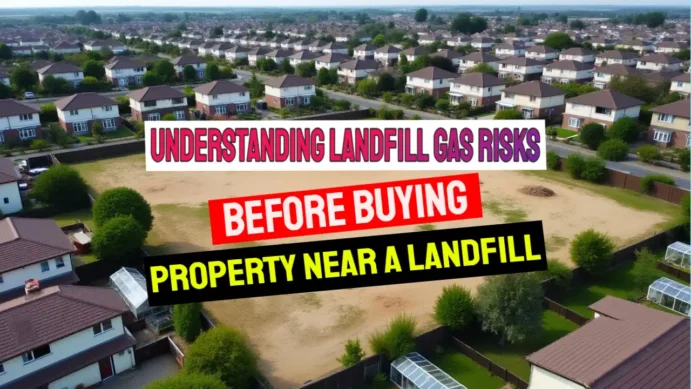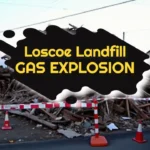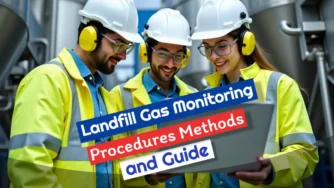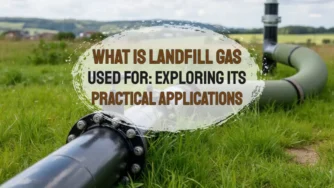Buying Real Estate: Understand Landfill Gas Risks before buying land near a landfill!
Landfill sites can produce methane, and that can continue for many years. It has been a known issue for years.
Site operators used to see small landfill gas fires as minor problems when they first started to happen in the 1970s in the UK and the US, as the amount of rotting waste (such as food waste) in the garbage rose. But, methane from waste was not a big worry when sites were small and far from towns.
Now, there's more pressure to build on land near old landfills. This has led to real estate being developed close to these sites.
When buying property, it's important to be careful, given these risks.
Many old landfills have been made safe and used for parks. They are often levelled and covered in grass. This can be a good use, but problems can arise if gas moves sideways or up.
Old examples show these issues. Newer ones are rare, but the risks are real. Today, better measures are in place, but buyers should know about these dangers.
Key Takeaways
- Landfill gas is the primary hazard – methane and other gases can migrate significant distances and pose explosion risks for decades after landfill closure
- Ground settlement continues long-term – decomposing waste causes ongoing structural risks to buildings and infrastructure
- Chemical contamination persists – older landfills lack proper containment, allowing toxic substances to leach into soil and groundwater
- Food production risks are real – growing edible plants on improperly remediated landfill sites can lead to heavy metal poisoning and chemical exposure
- Professional assessment is essential – always consider conducting thorough site investigations, including gas monitoring and soil testing, before purchasing property very close to former landfills
- Modern remediation works – properly restored sites with gas extraction systems, impermeable caps, and uncontaminated soil can be safe for development
- Due diligence pays off – understanding these risks can help buyers avoid dangerous properties or negotiate better prices for properly remediated sites
Understanding the Primary Hazards of Landfill Sites
Properties near old landfills face three main risks. Each one poses different challenges for owners and buyers:
1. Landfill Gas – The Primary Hazard
Landfill gas is the biggest danger to properties near old waste sites. This gas mix may have up to 50-60% methane and 40-50% carbon dioxide, but can be much lower and yet still capable, in rare circumstances, of causing explosions and fires.
Migration of landfill gas can cause property fires as long as the proportion of methane exceeds the lower limit for combustion, and sometimes migration of this gas may extend a surprisingly long distance from the landfill.
It also has small amounts of hydrogen sulfide and other harmful gases.
The dangers of landfill gas include:
- Explosion risk: Methane can explode at 5-15% in air
- Asphyxiation hazard: Methane can replace oxygen in closed spaces
- Migration risk: Gases can move through soil, entering buildings
- Toxic components: Hydrogen sulfide and other gases can harm health
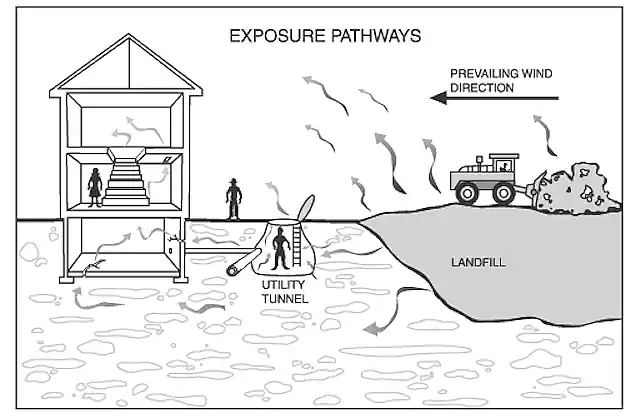
2. Ground Settlement Issues
Differential settlement happens as landfill waste decomposes. This can damage buildings and infrastructure if built very close to a deep landfill over time.
- Structural damage to buildings
- Damage to roads, utilities, and drainage
- Uneven landscaping and gardens
- Potential failure of underground utilities
The rate and extent of settlement vary, and as the waste settles, it also contracts in volume. It is surprising just how much of a void can be seen to open up when one stands on the edge of a vertical quarry cliff, due to this “volume shrinkage effect”. Sites with more organic waste face the biggest problems.
3. Chemical Contamination
Old landfills often had poor controls on what was dumped. This leads to ongoing contamination risks. Landfills accepted many harmful materials before modern rules.
- Industrial chemicals and solvents
- Heavy metals from manufacturing waste
- Household hazardous waste
- Medical and pharmaceutical waste
- Pesticides and herbicides
These contaminants can pollute soil and water, posing long-term health risks. A contamination plume may develop around and below an old landfill, and over many years, this may contaminate the soils of leachate waterlogged gardens.
Food Production Risks on Former Landfill Sites
Properties on landfills with hazardous chemicals face serious food production risks. Growing food on contaminated soil can be very dangerous. In rare cases this might extend beyond the landfill perimeter.
Heavy Metal Contamination
Heavy metals like lead, cadmium, mercury, and arsenic are big worries. They can build up in plants we eat. These metals:
- Get into plants through their roots from polluted soil
- Build up in different parts of plants (leaves, roots, or fruits)
- Can't be washed or cooked away
- Can harm health, causing brain damage, kidney disease, and cancer
Chemical Uptake in Plants
Plants also soak up volatile organic compounds and industrial chemicals. This is true for:
- Leafy greens like lettuce and spinach
- Root veggies such as potatoes and carrots
- Herbs that hold compounds in their leaves
Even with clean topsoil on top, contamination can move up. This happens through capillary action or plant roots reaching down.
Landfill Gas Explosion, Methane Migration and Fires – Case Histories from the USA
Case A – Building explosion, Atlanta, Georgia, 1967
One of the first explosions thought to involve landfill gas in a building occurred in Atlanta, Georgia in December 1967. Originally, the building was constructed with one storey and a basement and the latter was eventually bricked off, thus isolating it.
The only connecting passage from the basement to the upper storey was a 6-inch diameter pipe through which a 3-inch gas pipe ran. The gap between the pipes was not sealed. Landfill gas escaped through the gap and was ignited by a cigarette, resulting in an explosion.
This completely demolished the building, with two people being killed and two suffering serious injury.
Case B – Armoury, Winston-Salem, North Carolina, methane migration
In 1962, an armoury was built close to an operating landfill in Winston-Salem, North Carolina. The landfill was from 3 to 13 metres deep, and during the mid-60's, combustible gases accumulated in nearby sewers and minor fires and explosions occurred during the deposition of waste.
In September 1969 an explosion, thought to be caused by smoking, occurred in the building in which 25 people were injured and 3 died. Migration of landfill gas into the building may have been encouraged by the placement of additional cover material on the fill about a week before the incident.
Case C – Branford Landfill, Los Angeles, methane migration
In Los Angeles, at the Branford landfill, which was situated in a gravel pit, concentrations of methane well above the lower explosive limit were found up to about 150 m from the edge of the fill.
Initial attempts to control methane migration by installation of standpipes and trenches were unsuccessful. The reason for the failure is not clear, but it was probably due to the depth of the site, which was considerable.
Case D – Sheldon-Arleta Landfill, Los Angeles
Also in Los Angeles, at the Sheldon-Arleta landfill, similar gas migration problems were encountered to those in case 11. Since the Sheldon-Arleta site is in a residential neighbourhood, it was essential to take rapid remedial action.
A series of wells 8 m deep, spaced on 50 m centres, was installed just within the landfill boundary. Each well had a designed withdrawal rate of 200 cubic ft/min and was linked together with the landfill gas being flared off.
This site is of particular interest because it demonstrates the need to install a gas migration control system, and that by so doing, landfill gas could be controlled. This subsequently gave rise to the present industry based on the extraction of landfill gas with subsequent utilisation.
This early experience in California gave impetus to the new technology of landfill gas utilisation for power generation.
That landfill gas can be an energy source is of only passing interest to the real estate buyer, but it is important nevertheless, as it shows just how much energy is present in the landfill gas.
This early work in California sparked the use of landfill gas for power. While not directly relevant to real estate, it highlights the energy in landfill gas and its explosion risk if not managed.
For an example of a UK landfill gas migration explosion, visit our article about a bungalow beside a landfill that exploded in Derbyshire, UK.
CONTROL OF LANDFILL GAS MIGRATION REMOVES EXPLOSION HAZARDS
When buying property, it's key to know about landfill risks. If a development is near a landfill, problems can arise. Usually, experts like planners and architects are aware of these risks.
They take steps to make the land safe. This means the risk for buyers is very low. Buyers can be sure of this after doing their homework or getting advice from experts.
There are many ways to make land safe. Buildings might have special designs to lower explosion risks. But it's wise for buyers to check things out themselves.
IF DOUBT REMAINS, CARRY OUT A REAL ESTATE SITE METHANE SURVEY
If a property is near a landfill, methane checks are a good idea. Methane can be in the ground or property. A methane survey is recommended.
Experts can use boreholes or pits to test for methane. They use special tools to measure gas levels. It's important to have these tests done by qualified people.
Understanding landfill gas risks is smart when buying near landfills. This way, buyers can avoid future problems. They might even find a great deal on land that's safe from landfill gas risks.
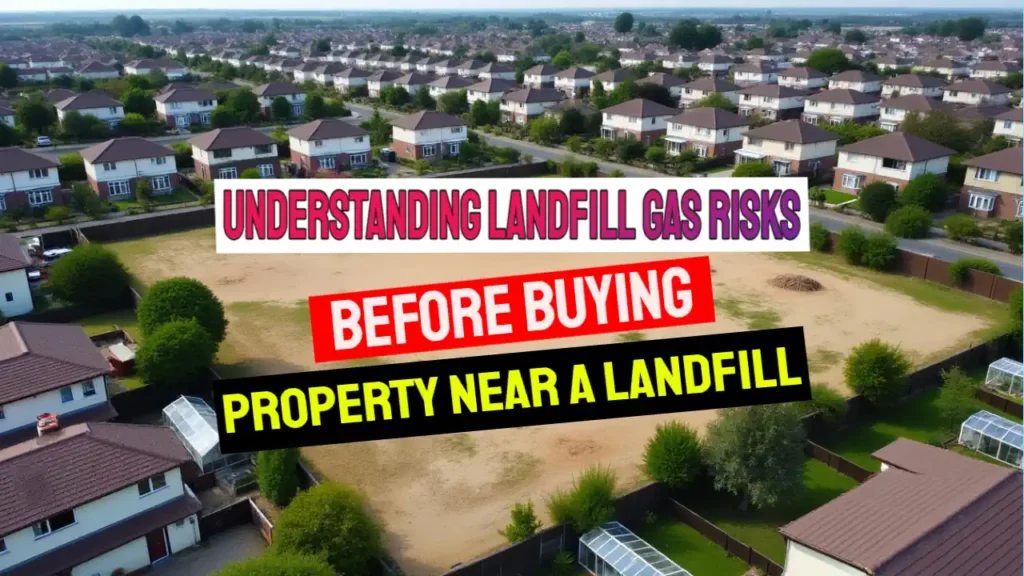
Conclusion to Landfill Gas Risks and Buying Property Near a Landfill
The astute real estate buyer will ensure that by understanding landfill gas aspects when buying property near landfills – closed or open – he avoids losses later. It is also possible, of course, that by heeding this article and carrying out a site investigation, a true bargain real estate purchase may be possible.
Other buyers may simply not be willing to make an offer for such land, which in many cases may be proven by investigation to be landfill gas risk-free.
Frequently Asked Questions
How long do landfills produce dangerous gases?
Landfill gas production typically continues for 20-30 years after closure, though some sites may produce gas for even longer depending on the waste composition and environmental conditions.
How far can landfill gas migrate from the source?
Landfill gas can migrate through soil for distances of 150 metres or more from the landfill boundary. The actual distance depends on soil permeability, gas production rates, and geological conditions.
What are the signs of landfill gas problems in buildings?
Warning signs include unusual odours (rotten egg smell from hydrogen sulphide), dead vegetation in patches, visible gas seepage from the ground, and unexplained accumulations of gas in basements or enclosed areas.
Is it safe to buy property near an old landfill?
It can be safe if the property has been properly investigated and any necessary remediation completed. This includes gas extraction systems, impermeable barriers, and verification through professional monitoring.
Can contaminated landfill soil be made safe for gardening?
Yes, but only through proper remediation involving the removal of contaminated soil and replacement with verified clean soil to sufficient depth. A simple layer of topsoil is not adequate protection.
What professional services should I hire before buying near a landfill?
Engage environmental consultants for gas monitoring, soil testing, and groundwater assessment. Also, consult structural engineers familiar with settlement issues and ensure legal advisers review all environmental reports and warranties.
Are newer landfills safer than older ones?
Generally, yes, as modern landfills are required to have liner systems, gas collection systems, and environmental monitoring. However, all landfill sites require careful evaluation regardless of age.
What building features help protect against landfill gas?
Protective measures include gas-resistant membranes beneath foundations, ventilation systems to prevent gas accumulation, gas detection systems, and specially designed foundations that minimise gas intrusion pathways.
[Published Nov 24, 2012. Updated August 2025.]
The Loscoe Landfill Gas Explosion: When Weather Turned Deadly at a Derbyshire Landfill
How a sudden drop in atmospheric pressure triggered a catastrophic landfill gas explosion that destroyed a home and changed landfill safety forever On a seemingly ordinary day in March 1986, the residents of Loscoe, a small village in Derbyshire, had no idea they were living above a ticking time bomb. What happened next would become […]
Landfill Site Permit Applications – The Role of Risk Assessments in Emissions Control
Landfill site emissions risk assessments are a mandatory requirement for environmental permit applications (previously known as Landfill Site PPC Applications). They identify possible hazards to the environment and public health from landfill gas and leachate. The procedure calls for a thorough examination of landfill emissions, including assessments of the effects on the air, groundwater, and surface […]
Landfill Gas Migration Defined and Explained
Landfill gas migration is defined as the process which occurs when the landfill gas generated within a landfill moves from the site of original waste deposition out of the landfilled waste, into the surrounding environment. This may take place as a result of the gas flow induced by the positive gas pressure produced by the […]
Fugitive Emissions of Methane and Landfill Gas Explained
It is well known that fugitive emissions of methane and landfill gas occur when methane escapes from production facilities, wells, pipes, compressors and other equipment associated with coal mining or natural gas extraction, landfills, and biogas plants. It is obviously very important to reduce fugitive emissions to an absolute minimum. Why are Fugitive Escapes of […]

